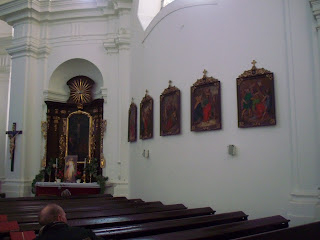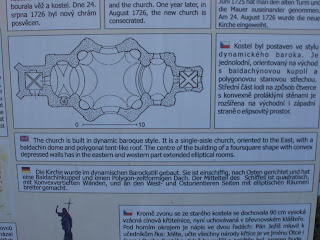Slowly out of the fog, some of the hilltops appear above the Labe River in East Bohemia in the town of Počaply (this side of the river). It is a frosty, cold morning, as we trudge along the river banks in our hip wader boots, collecting Phalaris.
The sun emerges and the horizon lights up with sleeping villages across the river.The trees have shed most of their leaves and stand eerily through the fog...gorgeous reflections in the still river.
As we start that morning, several Swans came along looking for handouts. Here they readily come to people and are quite tame.
This one is eating Phalaris...it must be one of their favorite plants on the river's edge as that was all that they ate (if they weren't fed)...carefully skipping over every other type of plant.
We had parked right next to the sleepy river and this Baroque church which stands darkly against the horizon. It is right against the river and part of the river ecosystem, as you shall see...
We make our Phalaris collections (a great population for sampling, as the river had flooded in 2002 and spread Phalaris in wide swathes back from the river's edge....including into the churchyard!
Here's a description of the church and the architect. This is a church in pure Baroque style which was built to replace the original structure which fell down.
and a bit about the published history of this church:
Ah, now the sunrise starts to light up the church.
We venture inside the gates to explore this Baroque beauty, a treat after we're done collecting! Mark had already ventured inside the gates and the church while we were out collecting.
Here the outside cemetery that surrounds the church (typical of churches here in Bohemia) is full of flowers for the upcoming All Saints Day (Nov. 1). Today, many people are coming to make sure that the graves are all decorated for this event. And, incidentally, as we drove past other cemeteries at night, they were all lit with candles!
The Priest is helping with the cemetery preparations and stops to chat with Jan as we explore this architectural treasure.
As we enter, the pure Baroque style in its magnificence delights our eyes...
Interesting font for holy water (grapes seem to be a theme!)....
Some up-close views of the incredible Baroque style carvings, paintings, and gold ornamentation on the altar and other furnishings.
We smiled and exchanged greetings with some of the parishoners and family that had come by that morning during the week. We remarked to each other how similar this scene was to those we had experienced in eastern Wisconsin, U.S.A. The people looked so familiar! Numerous Czech immigrants settled in eastern Wisconsin as well as Minnesota, so no wonder this all seemed too familiar.
Now, a few notes about the devastating flood of 2002: When the Labe River flooded so severely, as did many other rivers in the Czech Republic, a disastor awaited the church and town. You can see that the flood waters went several meters high....almost to the top of the main entrance door! It went over the tall walls surroundings the grounds...
Here is a picture of the church from the other side of the Labe River:
Views of the damage done to the inside of the church:
Disclaimer: This blog is not an official University of Minnesota or Fulbright Program blog. The views expressed are my own and not those of the Fulbright Program, the U.S. Department of State or any of its partner organizations, or the University of Minnesota.
































No comments:
Post a Comment